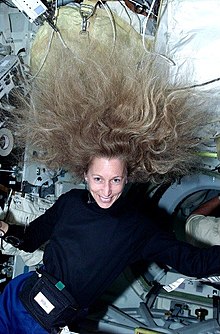Marsha Ivins
| Marsha Sue Ivins | |
 Marsha Ivins i tyngdlöshet. | |
| NASA-astronaut | |
|---|---|
| Född | 15 april 1951 Baltimore, Maryland |
| Tid i rymden | 55 dagar, 21 timmar, 48 minuter |
| Urvalsgrupp | Astronautgrupp 10 |
| Uppdrag | STS-32, STS-46, STS-62, STS-81, STS-98 |
| Uppdragsemblem | |
Marsha Sue Ivins, född 15 april 1951 i Baltimore, Maryland, är en amerikansk astronaut uttagen i astronautgrupp 10 den 23 maj 1984.
Rymdfärder
- STS-32
- STS-46
- STS-62
- STS-81
- STS-98
- Hon var uppdragsspecialist ombord på Atlantis/STS-98. Uppdraget var att föra upp och montera fast modulen Destiny Laboratory Module till den internationella rymdstationen ISS.
Källor
”Biographical Data” (på engelska) (PDF). NASA. 1 2011. https://www.nasa.gov/wp-content/uploads/2016/01/ivins_marsha.pdf?emrc=f893fd. Läst 28 april 2024.
Media som används på denna webbplats
The crew patch for STS-81 , the fifth Shuttle-Mir docking mission, is shaped to represent the Roman numeral V. The Shuttle Atlantis is launching toward a rendezvous with Russia's Mir Space Station, silhouetted in the background. Atlantis and the STS-81 crew spent several days docked to Mir during which time Jerry M. Lineger (NASA-Mir-4) replaced astronaut John Blaha (NASA-Mir-3) as the U.S. crew member onboard Mir. The U.S. and Russian flags are depicted along with the names of the shuttle crew.
STS-62 Mission Insignia
STS-32 Mission Insignia
- The STS-32 patch, designed by the five crewmembers for the January, 1990 space mission, depicts the Space Shuttle orbiter rendezvousing with the Long Duration Exposure Facility (LDEF) satellite from above and the Syncom satellite successfully deployed and on its way to geosynchronous orbit. Five stars represent the mission number with three on one side of the orbiter and two on the other. The seven major rays of the sun are in remembrance of the crewmembers for STS 51-L. In preparation for the first Extended Duration Orbiter (EDO) missions, STS-32 conducted a number of medical and middeck scientific experiments. The caduceus on the left represents the medical experiments, and the crystalline structure on the right represents the materials science. The crew is comprised of Astronauts Daniel C. Brandenstein, James D. Wetherbee, Bonnie Dunbar, Marsha S. Ivins, and G. David Low.
STS-46 Mission Insignia
This is the insignia for STS-98, which marks a major milestone in assembly of the International Space Station (ISS).
- Atlantis' crew will deliver the United States Laboratory, Destiny, to the ISS. Destiny will be the centerpiece of the ISS, a weightless laboratory where expedition crews will perform unprecedented research in the life sciences, materials sciences, Earth sciences, and microgravity sciences. The laboratory is also the nerve center of the Station, performing guidance, control, power distribution, and life support functions. With Destiny's arrival, the Station will begin to fulfill its promise of returning the benefits of space research to Earth's citizens.
- The crew patch depicts the Space Shuttle with Destiny held high above the payload bay just before its attachment to the ISS. Red and white stripes, with a deep blue field of white stars, border the Shuttle and Destiny to symbolize the continuing contribution of the United States to the ISS. The constellation Hercules, seen just below Destiny, captures the Shuttle and Station's team efforts in bringing the promise of orbital scientific research to life. The reflection of Earth in Destiny's window emphasizes the connection between space exploration and life on Earth.






